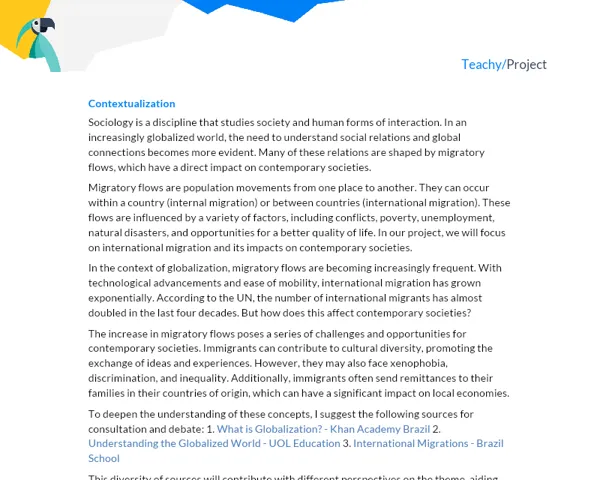Contextualization
Mass Culture is a perennial and prolific phenomenon in the contemporary world and permeates various aspects of our daily lives. It is a multidisciplinary concept that lies at the intersection of Sociology, History, Anthropology, and Communication. Simply put, mass culture refers to cultural productions that are made on a large scale for a vast population. It is generally disseminated through mass media such as television, cinema, radio, print media, and digital media.
In sociology, mass culture is seen as a manifestation of contemporary consumer society. It is categorized by the industrialized production of cultural goods that are passively consumed by the population. In history, mass culture is seen as a consequence of the Industrial Revolution and the advent of mass media. Thus, mass culture is understood as a phenomenon that has profoundly transformed the way people live, think, and interact in the contemporary world.
On the other hand, there are criticisms of mass culture that consider it a form of alienation, in which people are manipulated to consume products and ideas that are not necessarily beneficial to them. These criticisms come from various directions, including Marxist theorists, the Frankfurt School, and several postmodern theorists. Mass culture is also accused of promoting stereotypes, homogenizing culture, and eroding local culture.
Mass culture is a central element of globalization. It not only reflects global trends but also shapes them. This is evident in the predominance of certain forms of entertainment - such as pop music, Hollywood movies, and global brands - in almost every part of the world. In this sense, mass culture plays a significant role in shaping global identity.
Some reliable resources for understanding this topic are listed below:
- Mass Culture: What It Is, Characteristics, Influences, and Examples
- Mass Culture in Debate
- Mass Culture, Popular Culture: A Conceptual Discussion
Practical Activity: Mass Cultural Analysis
Activity Title: Mass Culture: A Case Study
Project Objective:
The objective of this project is to allow students to critically examine a specific element of mass culture (e.g. a film, TV show, music, or social media phenomenon) and analyze its influence, sociological, psychological, and cultural aspects. Students will be able to contextualize mass culture within the framework of contemporary global society.
Detailed Project Description:
In this project, students will be divided into groups of 3 to 5 and will select a specific topic related to mass culture. As part of the project, groups must:
-
Identify and analyze the selected topic.
-
Clearly describe the relevance of the topic in mass culture.
-
Analyze the influence of the topic on different demographic groups.
-
Evaluate the representation of this topic from a global perspective.
-
Present an analysis of the influence of this topic on society as a whole, including positive and negative aspects.
Students should apply the theoretical concepts learned in Sociology and Communication classes (e.g. critical theory, gatekeeping theory, agenda-setting theory) to analyze the selected topic.
Required Materials:
- Internet access
- Presentation materials (can be digital or physical, such as slides or posters)
- Research resources selected by the teacher and the students themselves
Detailed Step-by-Step Guide for the Activity:
-
Group Formation: Students will be divided into groups of 3 to 5.
-
Topic Selection: Each group must select a specific element of mass culture for analysis.
-
Research: Students must conduct extensive research on the chosen topic. They should collect data, facts, expert opinions, academic analyses, media examples, and any other relevant information.
-
Analysis and Interpretation: Based on the research conducted, groups must analyze the relevance of the selected topic in mass culture, its influence on different demographic groups, its representation from a global perspective, and its overall influence on society.
-
Presentation Preparation: Each group must prepare a detailed presentation discussing their findings and analyses. The presentation should be clear, informative, and engaging.
-
Presentation: Each group will present their case study to the class and be prepared for questions and discussions.
Project Deliverables:
Students must deliver:
-
A detailed visual presentation of the case study.
-
A written document detailing the case study including the following main topics:
-
Introduction: Students should introduce the selected study topic, its relevance in mass culture, and the study's objective.
-
Development: Students should discuss the theory behind mass culture, explain the selected element of mass culture in detail, explain how they conducted the research and analysis of this topic, and present the results obtained.
-
Conclusions: Students should conclude the work by summarizing their main points, discussing the lessons learned, and drawing conclusions about the impact of the selected element of mass culture on society.
-
Bibliography: Students should indicate all research sources used for the project.
-
The written document should complement the visual presentation and provide greater depth and detail in the analysis of the selected topic.
Students will have more than 12 hours per student to complete this project, reflecting the complexity and breadth of the topic. Through this project, students will learn to work in teams, manage time, research, and critically analyze a complex cultural phenomenon.

